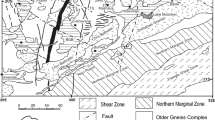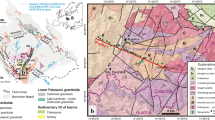Abstract
Integrative gravity modelling reveals the 3D shape, subsurface extent and basal morphology of the late-Variscan granites in the northwestern Bohemian Massif. The combination of the results with structural and geochronological data enables the interpretation of the morphogenesis and the tectonic setting of the granite emplacement. For the subsurface shaping two gravity methods were used: the Linsser filtering and the 2.5D density modelling. The Linsser filtering enables tomographic analyses of the gravity field in successive depth levels. The 2.5D density models were computed by the GRAVMAG program (version 1.5, British Geological Survey) which interprets gravity data vs. geological cross sections. At depth, the granites show steep- and flat-sided, wedge-like plutons which are generally elongated in north–northwest–south–southeast direction. The maximum basal depths between 3 and 8 km occur along the root zones indicated by high gravity magnitudes. The western- and easternmost granites (e.g. Leuchtenberg, Bor) are deeply eroded, whereas the granites in the central part (e.g. Falkenberg, Rozvadov) are greatly buried in the metamorphic host rocks. In the northern Oberpfalz, the plutons show a west-sided basal asymmmetry, and in the western Bohemia, in contrast, the plutons have an east-sided basal asymmetry. The steep pluton flanks parallel north–northwest–south–southeast gravity gradients which result from the high density contrast of the granites and host rocks. The density contrasts are caused by steep faults which enabled the emplacement of the granites. The shape, basal morphology, depth and volume of the plutons presume a genetic link between magma intrusion and shear deformation. However, the orientation of the plutons 15–20° off the trend of the major faults and structural data suggest emplacement into opening fractures along initially transtensional faults owing to the Lower to Upper Carboniferous extension in the northwestern Bohemian Massif.
Similar content being viewed by others
Author information
Authors and Affiliations
Additional information
Received: 30 June 1996/Accepted: 24 November 1996
Rights and permissions
About this article
Cite this article
Trzebski, R., Behr, H. & Conrad, W. Subsurface distribution and tectonic setting of the late-Variscan granites in the northwestern Bohemian Massif. Geol Rundsch 86 (Suppl 1), S64–S78 (1997). https://doi.org/10.1007/PL00014666
Issue Date:
DOI: https://doi.org/10.1007/PL00014666




